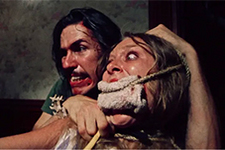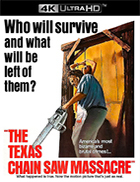The Texas Chain Saw Massacre (1974) (4K UHD)
|  Like a lot of budding horrors fans who grew up in the 1980s, I came to Tobe Hooper’s The Texas Chain Saw Massacre indirectly. Long before I ever actually saw the film, I knew it, primarily through the Video Treasures videocassette box I saw over and over again at local video stores, the front emblazoned with an artistic rendering of Leatherface, his eyes wild and unhinged through his mask of human skin, flanked on either side by close-up eyes wide in fright. It was the back of the box, though, that really gets you, as it had only a single image, that of Leatherface carrying a struggling victim toward a bloody meat hook that hangs prominently in the foreground. Nothing good could possibly come from that set-up. I also knew The Texas Chain Saw Massacre through another film: the Carl Reiner comedy Summer School (1987) starring Mark Harmon, which was on endless rotation on cable television in the late 1980s. A comedy about a lazy high school coach coerced into teaching remedial English during the summer to a group of adolescent misfits, it featured two characters, Chainsaw (Dean Cameron) and Dave (Gary Riley), who were obsessed with horror movies, especially Texas Chain Saw. In one scene they try to impress a beautiful foreign exchange student by convincing her to watch the movie. When she asks if it is good, Dave says happily in a parody of Siskel-and-Ebert-style movie reviewing, “Oh, I gotta tell you, I love this film. It has passion and a plucky spirit and the characters have integrity.” Chainsaw then chimes in, saying, “Dave, I agree with you, but I’ll go a step further. Sure, Leatherface, he made a mask out of human skin and he hung people on meat hooks, but hey! We’ve all got quirks! You’ve got ’em, I’ve got ’em.” They both give the film the proverbial thumbs up, and later in the movie they convince their teacher to allow them to screen it in class, and those few fleeting seconds of Leatherface chasing a screaming victim as she tries desperately to escape were the first images of the actual film I ever saw. The prominence of The Texas Chain Saw Massacre in a mainstream Hollywood comedy a little over a decade after its release is weird testament to how deeply this low-budget, independently produced horror film had worked its way into American culture. The title—so immediately attention grabbing, salacious, and ultimately misleading—is unforgettable, even for those who have never actually seen the film and naturally assume that it is much bloodier and gorier than it actually is (truth be told, almost all the violence is implied or kept just off-screen). Yet, that is just what draws us in, and for those willing to take the dive, Texas Chain Saw offers a masterclass in how to do unrelenting horror right—how to use every tool at your disposal to grip your audience and not let them go. The story, which was written by Kim Henkel and director Tobe Hooper, unfolds over the course of a day in the middle of sun-scorched Texas (the film was shot during an actual heat wave, and you can feel it on the screen), where a group of twentysomethings make the mistake of wandering off the beaten path when they visit a cemetery that has been recently vandalized to make sure that their grandfather’s grave has not been desecrated. The vandalizing of the cemetery is what opens the film, following a narrated text crawl and a very specific on-screen date (August 18, 1973), which purposefully gives the impression that it is based on a true story (it isn’t, although it was certainly inspired by the horrors of Wisconsin serial killer Ed Gein, who also inspired Robert Bloch to write Psycho). In sound and image, the film’s opening remains one of the most effectively unnerving opening sequences in horror movie history—so simple, yet so profoundly disturbing. Oscillating between total darkness where all we can hear are the sounds of heavy breathing and a shovel digging and brief flashes of the grotesque imagery of disinterred corpses, the scene is both jarring and engaging, daring us to want to see more. Each flash of light is matched with the exaggerated sound of an old-fashioned flash bursting and then dying, the quick visual fade-out matched with the distinct sound of the bulb dying in a high-pitched whine. The horrors of suggestion then give way to full visualization, as the camera slowly pulls back on the bizarre image of several decaying corpses posed atop a massive headstone in the otherwise beautiful early morning light, the ethereal mist around them contrasting with the blunt reality of radio broadcasts reporting the news of the desecration. We are then introduced to the film’s youthful protagonists: Sally Hardestry (Marilyn Burns) and her brother Franklin (Paul A. Partain) and their friends Jerry (Allen Danziger), Kirk (William Vail), and Pam (Teri McMinn), all of whom are travelling together through central Texas in a beat-up van. They are quickly recognizable as youth of their era, decked out in the visual signifiers of the hippie generation, which immediately puts them at odds with the rural culture through which they are travelling—strangers in a strange land. But, as victims always are, they are unaware of just how strange their surroundings are, although they get a glimpse when they make the mistake of picking up a hitchhiker (Edwin Neal), who proceeds to terrify them first with his raving and babbling about slaughterhouses, head cheese, and why sledgehammers are much better than air bolts for killing cattle and then by taking their picture, burning it, and slicing open his own palm. When they dump him by the side of the highway, they think their travails are over, but it is only beginning, as the abandoned family homestead they visit is right next door to the secluded home of a family of former slaughterhouse workers who have turned to butchering and eating human flesh. If we view the film as some kind of deranged satire of the American dream-turned-nightmare, it makes sense that the working class, rejected and replaced by automation, would turn consumption, the great American pastime, into cannibalism. Unaware of the horrors into which they have stumbled, the oblivious kids are bumped off one by one by Leatherface (Gunnar Hansen)—brained with a hammer, hung on a meat-hook, chainsawed in half—until only Sally is left. For her, being turned into dinner would have been a better fate than having to be the forced guest at dinner, which Hooper presents as a grotesque parody of old-fashioned Americana mealtime, with Leatherface, his mask of human skin adorned with make-up and wearing an apron like a harried housewife, the old man (Jim Siedow) barking orders at his younger hitchhiker brother like a gruff father figure, and the barely living grandfather (John Dugan) trying and failing over and over (and over again) to kill Sally with a hammer like in the good ol’ days. There is so much going on in this sequence—viscerally in terms of sound and image, but also thematically and symbolically—that it becomes nearly overwhelming, and when Sally escapes and flings herself through a glass window, you feel like you are falling right there with her, wild-eyed and gasping for breath. The spectacle of everything traditionally cherished in American culture—the multi-generational family, the dinner table, the breaking of bread (or bones) together, strict gender roles—turns into a nightmarish caricature of such grossly ludicrous proportions is part of what elevates Texas Chain Saw above its many imitators. It is absurd, but it also works. Despite its lowly status as an independently produced horror film intended for the drive-in and grindhouse circuit of the mid-1970s, The Texas Chain Saw Massacre has become one of the most studied and written about of American horror movies. It has been analyzed culturally, in terms of its evocation of the unstable Vietnam era with its gas shortages, social squabbling, and generation gaps; institutionally, particularly its hallowed place at the top of the midnight-movie cult circuit; and as a twist on fairy tales and folklore. As a horror film, it is now considered alongside Alfred Hitchcock’s Psycho (1960) as a fundamental game-changer, especially the way it took the logic of Hitch’s thriller to its literal ends in depicting the family as not a refuge from horror, but the very source of it. The countryside, once a place of respite and authenticity, is now a den of barely concealed horrors, many emanating from the very cultural, institutional, and financial shifts that were supposed to make America even better. Those who get left behind, as it turns out, will turn on us. However, the film is probably best described by critic Robin Wood as having “the authentic quality of a nightmare” (critic Kim Newman writes that it “is only defensible as a nightmare”). Like any nightmare, everything that happens in The Texas Chain Saw Massacre is both horrifying and logically questionable, although we only feel the former in the moment. The sensation, the experience, that the film generates with its constantly escalating tension, enveloping soundtrack, and relentless march into oblivion makes it feel inescapable—a trap into which we, like the film’s protagonists, have stumbled into and have to endure. Wes Craven, whose The Hills Have Eyes (1977) clearly took a few pointers from Hooper’s film, said in an interview that it “looked like someone stole a camera and started killing people. It had a wild, feral energy that I had never seen before, with none of the cultural Band-Aids that soften things. It wasn’t nice, not nice at all. I was scared shitless.” The image of Leatherface suddenly appearing in a doorway is the true stuff of nightmares, the feral energy Craven talks about, as is the carefully designed details of the clan’s farmhouse, which mixes familiar objects with furniture and knick-knacks made of human bones, all coated in a constantly shifting blanket of chicken feathers. The discordant musical score by Wayne Bell (who would go on to be a sound effects editor and mixer on dozens of major Hollywood productions) and Tobe Hooper pounds and grinds, the chainsaw rattles, and the victims scream. All the passion and pluck that Summer School’s Chainsaw and Dave loved so much hasn’t lost any of its impact.
Copyright © 2023 James Kendrick Thoughts? E-mail James Kendrick All images copyright © Dark Sky Films | |||||||||||||||||||||||||||||
Overall Rating: 


 (4)
(4)


